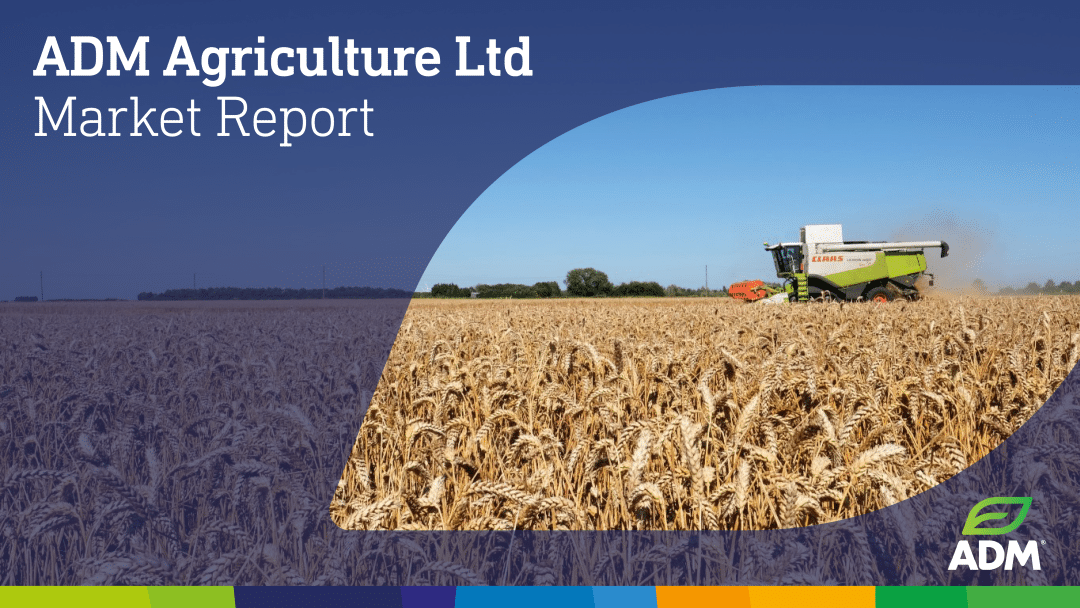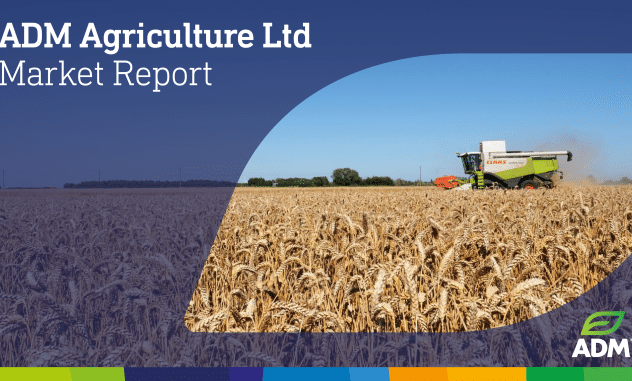WELCOME TO THE ADM AGRICULTURE WEEKLY MARKET REPORT
Wheat
Wheat futures saw significant declines across global markets due to economic uncertainty, trade tensions, and ample supply projections. CBOT wheat dropped over 50 cents per bushel, marking five consecutive losses. UK old crop wheat hit a contract low of £174.45/t before a slight recovery, while MATIF wheat futures in Europe reached a three-month low.
Key Factors:
- USDA forecasts indicate ample global wheat supply, limiting price support.
- Weak exports, US-China trade tensions, and a strong US dollar pressured markets. Month-end profit-taking also contributed to selling pressure.
- The Russia-Ukraine conflict remains a key concern, with European leaders discussing a potential truce. China continues diversifying imports, favouring South America over the US.
- Improved weather in US wheat-growing regions has reduced winterkill risks, supporting crop recovery.
Outlook
While prices showed a slight rebound later in the week, the market remains volatile, with a fragile bottom forming.
Malting Barley
Malting barley markets continue to struggle, with old crop premiums barely above feed values due to persistent weak demand.
Key Factors:
- New crop values are steady but increasingly vulnerable as optimal spring planting conditions support European supply.
- Supply concerns remain a long-term risk, but current weather conditions do not present an immediate threat.
Feed Barley
The feed barley market has remained quiet, with falling futures weighing on bids and reduced farmer selling limiting liquidity. Prices have declined but are showing more resilience than wheat due to tighter supply.
Key Factors:
- A weaker GBP midweek provided some demand support, potentially aiding price recovery.
- New crop markets remain weak amid sluggish demand and favourable spring planting conditions.
Outlook
While feed barley shows some resilience, both markets face pressure from weak demand and favourable growing conditions, making weather a key factor to watch.
Rapeseed
This week was dominated by tariff developments, with the U.S. implementing 25% tariffs on Canada and Mexico and doubling China’s tariff to 20%. Retaliatory measures included China imposing 10-15% tariffs on U.S. goods and Canada introducing 25% tariffs on $30 billion CAD of U.S. imports, with potential escalation. Discussions of rolling back tariffs on Canada and Mexico remain uncertain.
Soybeans
- Prices continued lower, finding support at $10.
- President Trump urged U.S. farmers to endure short-term pain for a larger trade deal with China.
- Weather remains mixed in South America, with dry conditions in Southern Brazil and Northern Argentina, while subsoil moisture levels in Argentina remain strong.
Energy Markets
- Oil prices declined due to fears of reduced global demand and OPEC+ plans to lift production quotas next month.
- U.S. tariffs impact Canadian crude, with 90% of exports heading to the U.S.
- China’s crude imports from Russia and Iran are expected to rebound as non-sanctioned tankers enter the trade.
Canola & Rapeseed
- Canola prices fell, with slow farmer selling and funds driving market action.
- The 25% tariff on Canola oil is a major blow, particularly given the U.S. ownership of Canadian crushers.
- MATIF rapeseed prices broke their long-term uptrend, closing below the 100-day moving average for the first time since September.
- A strong EUR/USD exchange rate contributed to the price drop, and while the EU is expected to receive Canadian canola, uncertainty remains due to trade volatility.
Outlook
Commodity markets remain highly sensitive to tariff developments, with trade uncertainty dictating price movements. Weather conditions and currency fluctuations will be key factors in the coming weeks.
Oats
The European oat market has seen some trade activity, largely driven by uncertainty over North American trade flows due to proposed tariffs on Canadian goods.
Key Factors:
- Scandinavian growers have been active sellers as old crop stocks are expected to be released from state reserves. Potential exports to the U.S. could provide market support, but confirmation is needed—otherwise, surplus stocks may pressure prices later in the year.
- EU Millers are well covered for old crop supplies and waiting for further clarity on U.S.-Canada trade developments.
- Feed oats have traded small volumes from the Baltics, but demand remains weak, with Spain well supplied.
- In the UK Market, millers are quiet, with key players covered until July 2025. Spring drilling has progressed on lighter soils, but wetter conditions in the Midlands require more drying time for heavy land.
Outlook:
Trade activity remains slow, with North American tariff decisions playing a key role in market direction. Market participants are in a wait-and-see mode as uncertainty persists.
Pulses
With spring drilling underway, pulse markets have been subdued as growers focus on planting and taking advantage of favourable weather conditions.
Key Factors:
- The recent GBP rally has made UK beans less competitive for export while improving the affordability of Dollar-denominated feedstuffs like Soybean Meal.
- Most UK regions have begun drilling, with forecasts predicting limited rainfall and above-average temperatures. Timely application of P and K fertilizers is crucial for maximizing yield potential.
- New crop premiums remain firm but are expected to soften as drilling advances. Farmers should explore marketing options, including Pool tonnage, futures-related contracts, and buy-back agreements.
- Processor demand for old crop peas is weak, but interest in new crop peas is growing. Buy-back contracts offer a structured selling opportunity, linking growers to advanced pulse processing facilities in Europe.
Outlook:
With drilling progressing well, market conditions remain stable. Farmers should consider strategic marketing options while ensuring strong crop management for optimal yields.
PGRO membership provides valuable pulse agronomy resources and advisory support.
Seed
Brighter weather has accelerated spring drillings, especially on lighter soils, leading to progress in planting.
Key Factors:
- Spring Wheat – Limited stocks of KWS Alicium spring wheat (Group 2 variety) remain available, known for its consistency over the years.
- Spring Oats – Stocks are becoming shorter, but limited quantities of market-leading varieties are still available for quick delivery.
- Spring Barley – Stocks of Laureate, RGT Planet, and RGT Asteroid have become scarce in some areas, with limited availability.
- Maize Seed – Demand remains strong, and a market-leading portfolio of maize seed is available.
Outlook:
While stocks for key spring crops are limited, there are still opportunities for quick deliveries. Farmers should act promptly to secure necessary seed varieties before supplies run low.
Our Spring and Maize catalogues are now available, browse our varieties here.
Our Winter Seed Catalogue will be available next week, be the first to browse our latest collection by signing up today. Simply email us to receive your copy via email enquiries.adm.agriculture@adm.com
Our seed specialists are on hand to help with any queries you may have, call our friendly team on 01427 421200.
Fertiliser
Natural Gas
- European natural gas futures have dropped below €41/MWh, hitting a three-month low due to milder weather reducing heating demand.
- Ongoing US-Ukraine tensions and tariff impacts add volatility, though short-term forecasts show above-average temperatures. A potential cold snap could drive prices higher again.
- Europe was the primary buyer of US LNG exports in February, driven by cold weather, low wind power, and reduced Russian gas flows. Demand could rise again if temperatures dip later in March.
Ammonia
- Global ammonia prices are expected to decline in Q2 and Q3 due to weak demand and strong supply at export hubs, particularly in Northwest Europe.
- Recent spot demand and resistance from Algerian producers have provided temporary support. Gas market volatility and potential Russian exports from Taman may slow price declines.
Ammonium Nitrate (AN)
- European demand for nitrates is rising with improved weather for farm applications. However, tight supply in the UK is a concern, with domestic producers commanding higher prices, discouraging imports.
- CF Fertilisers has reissued a price increase, though it remains below replacement values, exacerbating supply risks as spring progresses.
Urea
- Uncertainty persists as India delays its tender, but expectations of a potential tender next week may support prices, especially if US and Australian demand picks up.
- March urea prices in the Middle East have adjusted downward to $415/t FOB, with further reductions expected. China’s exports may resume in July, and Iran is set to restart exports soon.
- UK market prices remain firm, supported by tight supply and limited imports.
Potash
- Global potash prices are expected to rise due to US tariffs on Canadian MOP and supply constraints. The new 25% tariff on Canadian potash could disrupt US supply, causing domestic prices to surge.
- China and India are expected to settle new contracts at $315/t CFR and $320/t CFR, respectively, adding upward pressure on prices.
- In the UK Potash prices have increased modestly this week, reflecting global supply tightness.
Phosphates
- Phosphate prices remain firm due to supply constraints, with sellers retaining pricing power.
- European demand is steady, and the UK market has seen increased buying, leading to modest price increases. Prices are expected to hold steady globally, with potential upside in the US due to logistical challenges and strong demand.
Outlook
Global fertilizer and energy markets are facing volatility due to geopolitical factors, supply constraints, and shifting demand dynamics. While some prices are showing signs of tightening, regions like the US and UK will experience differing price pressures based on local conditions.
Our fertiliser specialists are on hand to help with any queries you may have, call our friendly team on 01427 421200.
| £/€ | £/$ | €/$ |
|---|---|---|
| 1.19270 | 1.2871 | 1.07939 |
| Feed Barley £ | Wheat £ | Beans £ | Oilseed Rape £ | |
|---|---|---|---|---|
| Mar 25 | 145-160 | 173 – 188 | 205-215 | 405-415 |
NB: Prices quoted are indicative only at the time of going to press and subject to location and quality.
Although ADM Agriculture takes steps to ensure the validity of all information contained within the ADM Agriculture Market Report, it makes no warranty as to the accuracy or completeness of such information. ADM Agriculture will have no liability or responsibility for the information or any action or failure to act based upon such information. ADM Agriculture cannot accept liability arising from errors or omissions in this publication. ADM Agriculture trade under AIC contracts which incorporate the arbitration clause. Terms and Conditions of Purchase.
On every occasion, without exception, grain and pulses will be bought by incorporating by reference the terms & conditions of the AIC No.1 Grain and Peas or Beans contract applicable on the date of the transaction. Also, we will always, and without exception, buy oilseed rape and linseed by incorporating by reference the terms & conditions of the respective terms of the FOSFA 26A and the FOSFA 9A contracts applicable on the date of the transaction. It is a condition of all such transactions that the seller is deemed to know, accept and understand the terms and conditions of each of the above contracts.



